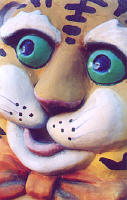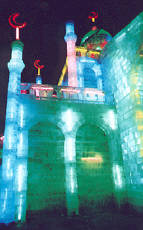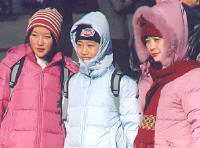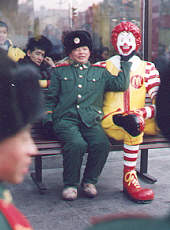A Winter’s Journey to Harbin
Harbin, China


A ferocious Harbin tiger.
![]()
![]()
Poring over the map now, as the snow falls on a January Massachusetts morning, I remember our train, the overnight express to Harbin, pulling out of Shen Yang Station, headed north into the cold dark night. Like most in China, the train was crowded and smoky with bunks stacked three-people-high. But fun. Everyone bought their food and drink – instant noodles, chocolate, green-bottled beer. The locals were amused to chat with us da bi zi, big-nosed foreigners.
During the night we slept as the train traversed Jilin and into Heilongjiang, the Province of The Black Dragon River. Bordering Russia, it’s home to the northernmost and coldest destinations in China.
Only a village a century ago, Harbin was dramatically changed, built up swiftly alongside Russia’s construction of the Trans-Siberian Railroad – a branch of which, the Trans-Manchurian – links the northeast of China. Once connected, the rail promoted Harbin, with its natural geography serving as a midway point between far-off destinations in both Asia and Europe. This brought the city trade, work and industry. With these changes came excitement and fashion, and tourists, leading some in the early 20
During the Japanese occupation of Manchuria, Harbin made up part of the puppet Manchukuo regime, painfully documented in the film, The Last Emperor. The Russians re-occupied it at the end of WWII for a time. Intriguing facts and tumultuous history like this had sparked our interest, but we’d also heard about the region’s most notable feature – the cold. Average temperatures during Harbin’s winter freeze hold in the -20C range, and can dip to -40C. At these temperatures, bears hibernate, and rivers and moustaches freeze. We wanted to feel this mercurial extreme for ourselves.


Ice castle lit at night.
![]()
![]()
![]()
In addition to encountering this weather of Doctor Zhivago proportions, we planned to see many of the fascinating sights the city has to offer. First off was the world-famous ice-carving festival in Zhao Lin Park, where artisans from around the world flock to chisel, carve and chainsaw their ice-encased inspirations. Constructed every January and viewable as long as the weather allows, the sculptures portray angels, dragons and ice-pieces in the abstract.
There are also ice castles and luges and world monuments, even a frosty Great Wall in miniature. Built completely out of ice, they’re attractive by day and the detail is amazing, but accompanied by colorful neon lighting and a cup of hot chocolate, are best seen at night. We also wanted to check out “The Tiger Zoo,” – as interesting testosterone-filled rumors had wafted their way down to Liaoning, our more southern province.
We arrived early, before five in the morning, and checked into a cheap nearby hotel as the sun was still hours from shining. After a rest and some hard-sought coffee (not yet a popular taste in China), we hit the city. My first impression was that the cold was more bearable than advertised, but I zipped up for the walk, nonetheless. After a harsh winter the previous year, the cold season of 2001-2002 turned out to be a mild one in northeast China, and temperatures in Harbin hovered above their frigid and typical lows. Regardless, the streets and sidewalks and occasional patches of turf were hard, and felt upon walking as if they were solidly frozen, deep into the ground.
Wandering lengthy blocks, we noticed several of the onion domes of Russian architecture as well as St. Sofia’s, a Russian Orthodox Church that had somehow weathered The Cultural Revolution. We also found scores of hotels and restaurants, all fronted by glowing New Year’s lanterns. Selecting one, we stopped for lunch and ordered the New Year’s daily special – dumplings, of course.


Learn from the locals: It’s cold. Bundle up.
![]()
![]()
After eating, we came upon Dao Li, a very European-esque shopping district. Cafes and galleries lined the streets which were fashionable and pedestrian friendly. Boutiques sold Chinese and Russian artwork, chocolates from around the world and an expensive local commodity, Siberian furs. Outside, many young Chinese soldiers, proudly clad in their green and red uniforms and hats, paraded through this downtown center in sharp formation, with some of them marching on through the golden arches of a busy McDonalds.
The next destination was the River Huan Song, an icy vista to behold and a pathway to sights beyond. Atop the deeply frozen river was a traffic of people at play. Adults and children skated and played games on makeshift sleds and other ice-traversing vehicles. There was even horseback riding around a snow-lined track with venders selling varied cold-weather drinks and spicy barbecued specialties.
Reaching the opposite shore – about half a mile across – we walked through a wintry ghostown, a collection of icicle-bound, dilapidated summer estates. They had once been the vacation spots of choice for many Russian aristocrats. After the fall of The Soviet Union, and the northern nation’s subsequent economic woes, they’ve been more or less abandoned to the elements.
One of the great experiences of travel is discovering new places and foods – ones you hadn’t planned or read about, or even knew existed. Maps are a must and we had several. The directions were often vague and unspecific, voiced by chambermaids in a language we didn’t really understand. We were led on adventures we couldn’t have planned. J.R.R. Tolkien said that “not all who wander are lost,” but at this particular intersection, conceding failure, we surrendered to a persistent taxi-in-a-minivan that escorted us to The Siberian Tiger Park.
The park houses about 200 tigers, lions and other carnivorous cats, including a handful of rare and massive white Siberian tigers. The zoo provided – and I’m searching for the right word here – entertainment unrefined! After paying and being led through a souvenirs-gauntlet, visitors walk through a safe, semi-enclosed walkway overlooking the tigers prowling below. The tigers are beautiful and playful, and even the cubs seem unfazed by the cold.


The Harbin army.
![]()
![]()
![]()
The big lure for this visit is that park patrons can purchase a live chicken, sheep, or cow (highest-priced at $125) to provide a live-action meal for the tigers while you watch. As you circle within their compound in a rickety, un-reinforced school bus, a dining car arrives on the scene, delivering the dinner you and your busmates sponsored, for the nearest cats to contend with! Nature with a twist of science fiction. Low on Ren Min Bi, Chinese currency, my buddy
and I could barely afford our bus ticket; hence we didn’t contribute to the hearty meal that afternoon. Because of this, we were snubbed and assigned aisle seats.
The tiger’s den was surrounded by gates. Along one particular stretch of chain-link, a snowdrift had built up to a height of four or five feet. We climbed it and peered over the flimsy, wavering top at the 400 pound tiger below who had clearly noted our arrival. He stretched towards us and put his paws high against the fence which groaned under his weight. It seemed like a precarious situation and I wondered if my travel insurance would cover this. We speculated how high that feline could jump, and how old that fence was, and on the ride home, we wondered if tigers usually eat chicken!
The City of Harbin, like the extreme and unadulterated Siberian Tiger attraction, is a mystery. Despite its chilling cold, it’s at its best when visited in winter. Adding to the city’s enticements is an interesting blend of Chinese and Russian architecture, culture and interwoven gene pool providing fascinating, exotic scenery.
The people of Harbin, with lots of ice and lights and wind-whistling nights, have taken advantage of their harsh climate and surroundings by creating a quirky winter wonderland. When I visited last February, the city wasn’t as cold as everyone had warned, but it was uniquely cool, and will remain a great experience, frozen hard in my memory.